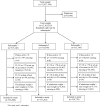Characterizing user engagement with health app data: a data mining approach
- PMID: 28616846
- PMCID: PMC5526821
- DOI: 10.1007/s13142-017-0508-y
Characterizing user engagement with health app data: a data mining approach
Abstract
The use of mobile health applications (apps) especially in the area of lifestyle behaviors has increased, thus providing unprecedented opportunities to develop health programs that can engage people in real-time and in the real-world. Yet, relatively little is known about which factors relate to the engagement of commercially available apps for health behaviors. This exploratory study examined behavioral engagement with a weight loss app, Lose It! and characterized higher versus lower engaged groups. Cross-sectional, anonymized data from Lose It! were analyzed (n = 12,427,196). This dataset was randomly split into 24 subsamples and three were used for this study (total n = 1,011,008). Classification and regression tree methods were used to identify subgroups of user engagement with one subsample, and descriptive analyses were conducted to examine other group characteristics associated with engagement. Data mining validation methods were conducted with two separate subsamples. On average, users engaged with the app for 29 days. Six unique subgroups were identified, and engagement for each subgroup varied, ranging from 3.5 to 172 days. Highly engaged subgroups were primarily distinguished by the customization of diet and exercise. Those less engaged were distinguished by weigh-ins and the customization of diet. Results were replicated in further analyses. Commercially-developed apps can reach large segments of the population, and data from these apps can provide insights into important app features that may aid in user engagement. Getting users to engage with a mobile health app is critical to the success of apps and interventions that are focused on health behavior change.
Keywords: Big data; Classification and regression tree; Data mining; Mobile health application; Mobile health technology; Smartphone app; User engagement.
Conflict of interest statement
Funding source
This work is a secondary data analysis and was not funded by a grant.
Conflicts of interest
The authors declare that they have no conflicts of interest.
Human rights and welfare of animals
The Office of Human Subjects Research Protections at the National Institutes of Health has determined that federal regulations for the protection of human subjects do not apply to this research activity. No animals were used in this research study.
Informed consent
This work is a secondary data analysis of commercial application data, and data given were de-identified. No consent was needed.
Figures
References
-
- Fox, S., & Duggan, M. (2012). Mobile health 2012. Retrieved from http://www.pewinternet.org/2012/11/08/mobile-health-2012/. Accessed 6 Oct 2016.
-
- Anderson, M. (2015). Technology device ownership: 2015. Retrieved from http://www.pewinternet.org/2015/10/29/technology-device-ownership-2015/. Accessed 6 Oct 2016.
-
- Smith, A. (2015). U.S. smartphone use in 2015. Retrieved from http://www.pewinternet.org/2015/04/01/us-smartphone-use-in-2015/. Accessed 6 Oct 2016.
MeSH terms
LinkOut - more resources
Full Text Sources
Other Literature Sources
Medical



